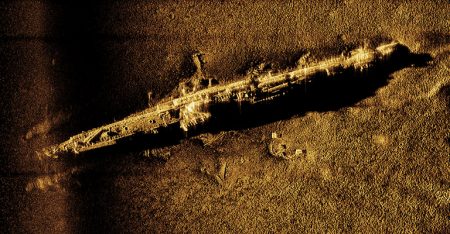Courtesy of NOAA Office of Exploration and Research and Kraken Robotics.
Rod Mather, professor of history at the University of Rhode Island and an experienced archeologist, is working on a new project involving the imagery of sunken submarines in the Narragansett Bay.
As a URI faculty member for about 20 years, Mather teaches maritime and Atlantic history, as well as underwater archeology.
The submarines at the focal point of his research have very close ties to the Ocean State, as well as the United States Navy. In collaboration with National Oceanic and Atmospheric Administration’s Office of Ocean Exploration and Research (NOAA OER) and Kraken Robotics, Mather’s newest project involves four sunken historic submarines. Using a new synthetic aperture sonar (SAS) system, the team has begun imaging the sunken submarines.
“The new images are 30 times more accurate than the images we had before,” Mather said. “We have imaged three of the submarines, and the next one to image is the USS Bass, which is in the deepest waters. The company is set up to do it, so the question is logistics. It probably won’t be until late spring or early summer.”
According to their website, Kraken Robotics are recognized as world leading innovators of SAS, a revolutionary underwater imaging technology that dramatically improves seabed surveys by providing ultra-high resolution imagery at superior coverage rates.
In Rhode Island, Kraken used their highly developed underwater vehicle called the Kraken Active Towfish, also known as KATFISH.
The collection of submarines has greater significance, both historically and archaeologically, than each one by itself.
On two of the wrecks, the German U853 and its victim, an American merchant ship the Black Point, there are human remains on board. As a result, research and excavation policies are more strict than that of the other wrecks.
At the conclusion of this final imaging, they can begin nominating sites to the national register, which will take about a year.
“It’s a big process, so it usually is done as a team,” Mather said. “I will talk to Navy History and Heritage Command and the Rhode Island Historic Preservation and Heritage Commission, and possibly develop a national register of historic places nomination to get the submarines on to the official register of historic places for the country.”
The current security and monitoring of the underwater sites is limited and is mainly controlled by the state. General rules about taking things off of archeological sites do apply, and the people of Rhode Island typically follow those rules. However, Mather is looking to extend that protection.
“People are able to go diving right down to the sites,” said Mather. “The purpose of the Naval protection is to help preserve historical sites, help people understand the nature of sites, and provide people information about the sites and the need to protect them, as well as the histories of them,” said Mather. “These are Navy ships, so in this case The Navy would take the lead in monitoring, regulating and coming up with plans for each individual site.”
Rhode Island is known for playing an important role in American undersea warfare, according to Mather.
“At the beginning of the Civil War, the Naval Academy in Annapolis was moved to Newport because it was too close to the front lines of the war,” he said. “In 1869, the Navy established a Torpedo Experimental and Development Facility on Goat Island, and so from that point on, Rhode Island has had a very important role in the development of undersea technology for the Navy.”
He goes on to say that it later became a torpedo manufacturing site, where a third of all torpedoes used in the second world war were manufactured, employing 13,000 people.
Mather’s research interests are in applied history. “Applied history involves the use of historical methods and understandings to improve public policy,” said Mather. “Every big issue we face today has a historical component; if you interrogate the historical record, you can develop better ideas and suggestions for public policy.”

